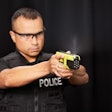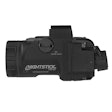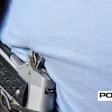Unfortunately, many street cops view the carrying of a full-sized duty pistol as just a necessary evil of doing business. This lack of interest in one of their primary survival tools is all too common with contemporary cops, especially as the hiring pool becomes more urbanized. Not having grown up around firearms, many of these officers simply have little or no interest in them. It makes you wonder if they may exhibit the same level of disregard toward the fire extinguisher or first-aid kit carried in their beat car? Let's hope not.
Yet, savvy officers not only understand the realities and the necessity of a well-maintained duty gun, but also comprehend another concern: There may indeed be a need for a backup to that full-sized holster gun.
There's an old adage among special units of the military and police (indeed, among anyone who relies upon equipment for their very lives) that "one of something is none, and two is one." Meaning, if you have one flashlight, one set of cuffs, one battery, then the moment it fails, you have none. If you have a backup to turn to, you are back in business. Hence, one may be none, and two will, in all actuality, be at least one.
Life Saver
So, if it applies to a flashlight (you do carry a backup, don't you?) and a spare battery for your portable radio, why not that all-critical duty gun?
With the plethora of exciting new designs in today's compact pistol and revolver market, there is virtually no reason not to carry a backup gun, unless your agency forbids the practice. And if it does, it may be time to pound the table and stomp your feet to change it.
From full-sized to tiny, almost toy-like autos and revolvers, any officer of any size or body build can find a design he or she can successfully conceal while on duty. There is virtually no reason to be without a second gun, and, if you cry foul due to prices, there are baseline models that cost less than a good coat. Few things in life are worse than that feeling of reaching down and finding your holster empty.
Believe me, I know.
I'm old enough to not care anymore about my own foibles from my days on duty. I'm a firm believer that if I can help others by publicizing my own screw-ups, then I have the duty to do it.
Empty Holster
After dropping a prisoner off at the county jail once, I went back on duty and conducted a traffic stop a short time after leaving the jail. As I stood next to the driver's window I noticed that his eyes were focused on my holster. Then they suddenly got a confused look, and he said, "Excuse me, but I think your pistol is missing."
My hand reflexively reached for the grip of my Smith & Wesson Model 19 revolver and closed on emptiness. For about three micro seconds my mind reeled and then I had a vision of my gun resting neatly in that lock box at the entrance to the jail. I handed the driver's license back with a mumbled "Drive safely," and then broke warp speed back to the jail. A Dodge 440 Magnum engine's growl is something to be appreciated at those moments.
So go ahead and ask me if my backup S&W Model 60 in my ankle holster felt comforting during that little drama. You bet. And, yes, I paid dearly in puns and sniggers for weeks afterward. Of course, some of those pointing fingers may have forgotten some of their own trespasses.
.32/.380 Convenience
All of this is a semi-roundabout way to get to a review of two interesting compact pistols. After hearing about the nifty little autos from North American Arms for quite a while, I finally got a pair to fuss with.
For about 25 years, North American has been manufacturing tiny .22-caliber single-action revolvers that are about thumb-sized and have probably ridden in more cop pockets than we care to mention.
But as tidy as the little revolvers were, both the single-action trigger mechanism and the small caliber left many potential buyers wishing for more. So, North American hired an engineer to help develop a pocket-sized .32 that would meet the needs of a primary carry gun for many non-sworn applications and as a "no-fuss" backup gun for cops.
When it was introduced, the North American .32 ACP Guardian garnered a considerable amount of interest. Looking a lot like the classic Seecamp design, the .32 Guardian differed in many areas. First off, it was actually available, while the Seecamp always suffered from slow delivery times due to its handmade nature. Secondly, it used some innovative manufacturing methods, like castings and metal injection molded (MIM) parts, to make it both affordable and readily available.
According to Ken Friel of North American, "The .32 and eventually the .380 were natural progressions from the revolvers."
As the .32 Guardian, and later the .380 Guardian developed, Kahr supplied machine work, Taurus supplied both engineering and MIM parts, and eventually CorBon partnered up and helped develop the .32 NAA. The .32 NAA-created specifically for North American Arms-is a .380 necked down to .32 that develops about 1,200 feet per second. It's sort of a "mini-magnum" if you will.
The all-stainless Guardians are double-action only (DAO), with no external safeties to clutter things up. The magazine release is in the correct spot, there is an external extractor, and the hammer is "bobbed" so it doesn't catch on things. Sights can be one of many choices, from tiny Novaks, to big dot sights from Express Sight Systems, and even an interesting "guttersnipe" sight is available.
You can also get porting (although I can't imagine exactly why) and a myriad of custom touches. Fancy scalloped grasping surfaces on the slide, frame stippling, and a wide range of custom grips, holsters, and a simple belt case that looks like a PDA carrier, are all available.
Just because the Guardians are pocket pistols, that doesn't mean they have to be boring or plain. Size does matter and the .32 model weighs in at around 14 ounces while the .32 NAA (the hot one) and the .380 tilt the scales at a modest 18 or so ounces.
The .380 is ever so slightly larger than the .32, in order to accommodate the bigger cartridge and manage the higher pressures and recoil levels. While most officers may believe a .380 is the minimum level of protection needed in a pocket pistol, the reality is the .32 and the .380 are virtually identical in the real world.
Both Guardian models are tuned to accept any commonly available factory ammo. Frankly, with penetration being critical with most of the minor calibers, many users elect to go with standard FMC "ball" ammo in order to enhance reliability and to garner reliable penetration should the need arise. The various hollow-point loads often perform unreliably at pocket-pistol velocities, and end up being "ball" rounds anyway due to the fact the hollow-point will often fail to open up.
On Target
I fell into a serious case of "like" with the little .32. It's just enough smaller than the .380 to be a real joy in the pocket and the fact it weighs a few ounces less than the .380 can actually be noticed. But that doesn't rule out the .380, since, in all seriousness, if you can tote one, you can easily tote the other. Still, there's just a nifty quotient the .32 has going for it that everyone who felt it commented on. The .380 feels more "gunny," while the .32 feels "cute," if you'll pardon my literary license. OK, so maybe cute isn't critical in a backup pistol, but it's still there.
Shooting revealed no surprises. However, a stiff wrist is important since these guns need a solid platform to recoil against, or a stoppage may occur. Groups hover around the 2-inch mark at 10 yards if you take your time.
The .380 version barks and bites more than you would imagine, similar to the situation with a .380 Walther vs. a .32 version of the same. According to North American's Friel, the .32 NAA mini-magnum bites hard enough that the company is redesigning the optional wooden grip so that it doesn't crack. Either way, I'd probably stick with the standard genuine Hogue rubber-like grips that come on the guns. They are slimmer than the custom wooden ones and the slightly "sticky" feel helps to control these little monsters.
North American has a law enforcement program. Friel says it will happily send out a test-and-evaluation gun for your agency and offers factory-direct pricing on agency letterhead.
All in all, the North American Guardians are aptly named for their intended role. They are reliable backup pistols, and even come with an unconditional lifetime warranty.
Roy Huntington is editor of American Handgunner and a member of the POLICE Advisory Board.

















